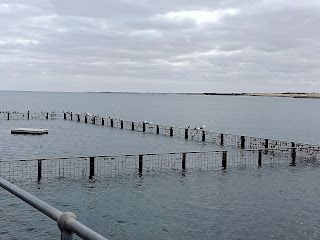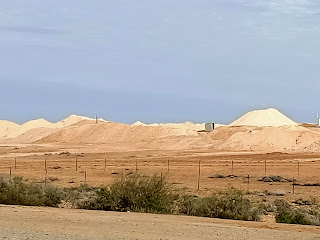Red dust, and more red dust. I think a more general term is 'Bull Dust'. The dust is a fine red aeolian dust which is formed from minute dry particles and when it is disturbed it forms into a choking dust. It gets inside cars, caravans and buildings and it fills the holes in roads. We were told to watch out for the deep potholes on tracks which are filled with dust, as they can ruin tyres and suspension if they are particularly deep or have sharp sides.
On the Sunday we tried to drive to the hot springs at Clayton, about 40 km along the Birdsville Track. There was a camping ground there, plus a huge hot tub. As the temperature was 30 degrees, with a hot dry desert wind, we were not tempted to try the hot tub, but thought a trip there would be interesting. After 10 kms of travelling on a terrible corrugated road, we turned back towards Marree. If we had deflated the tyres a bit it would have been less jarring.
Walter enquired at the store and was assured that we would be okay travelling on the Oodnadatta Track, before turning left onto the Borefield Road towards Roxby Downs. So we dispensed with the plan to return back along the main road to Quorn, and decided that north west would be the way to go. An extra 191 km onto the 780 km that we had already travelled.
The 191 km was going to be a slow bumpy drive!
After purchasing fly spray, for the pesky flies in the caravan, and some more expensive spring water., we drove to the pub. The bore water in Marree was terrible, even the filter in the caravan did not remove the metallic taste. There was no way we were going to fill our drinking water containers with that rubbish.
We realised that we did not have a shovel, or a good tyre pressure gauge or indeed a good tyre pump, the one we had was purchased in Halfords in the UK, and took ages to pump up tyres. But we had plenty of water, most important. We thought there would be enough traffic on the road should we experience any great difficulties.
The short trip to the pub was for our morning coffee, being a little early in the day for alcohol. And it was certainly very good coffee too. After admiring the dead plants with their little stick markers in the front garden of the pub, we sort forth. Someone must have been inspired to brighten up the front of the pub, but I guess the bore water killed the plants.
A wrecked car in the photograph below, as a reminder to take care. I think it had been dumped there as it was only a few kilometres out of Marree, and was covered in graffiti. A desolate place.
One of the many water tanks along the road, was a reminder of the Old Ghan railway which ran alongside the Oodnadatta Track. The steam engines had to stop at different points in order to fill up with water. The reason why the railway was built alongside the track was due to the many springs that lined this way north. Water was crucial.
After we travelled about 20 kms we passed two cyclists heading towards Marree. And we were worried about driving on the road! Luckily they had the strong desert wind behind them. I wonder how many tyres and tubes they used on their journey.
Just before we turned onto the Borefield Road, we saw the iconic sculptures at Mutonia Sculpture Park. The park is a bit of a misnomer really as it is a piece of scrub, but the sculptures are pretty spectacular. We did not see the turn off into the park so pulled up quickly on the road in order to take a few photos.
The most remarkable sculpture is off two small planes standing on their tail pieces, seen in the photograph below.
Finally the Borefield Road turnoff appeared in front of us, and we were very careful to not get our tyres caught in the bull dust holes in the road. We had been warned. The corrugation was pretty bad at this stage so travelling slowly was necessary.
Once on the Borefield Road, the road smoothed out a bit, due to it being maintained by BHP who have a gas line running along the side of the road. However, every crest we came to the corrugation was jarring to say the least.
Thank goodness for airconditioning though. It was hot outside.
After a few kilometres of jarring crescents Walter noticed that two of the side windows in the caravan were flapping, so we stopped to have a look. The corrugation had loosened the catches. And what a sight greeted us inside the caravan. My bed, luckily covered with the pop up toilet tent was a thick layer of red dust, as were the curtains. In fact the white net curtains were now red! There was thick dust on the floor and over the bench top at the back of the caravan.
What could one do at that point but lock the windows and keeping driving on.
We thought it was also a good photo opportunity. It was very hot and dry. I forgot to mention it was not a good idea to drive off the road, as the sides were soft. We did not fancy getting stuck, especially as we did not have a shovel.
Finally we made it to Olympic Dam, the mining site, with its township of Roxby Downs. There must be plenty of water underground here, as we saw trees and green grass. An oasis in the desert.
Unfortunately we could not stay overnight, as BHP had booked the cabins and motel units for its workers, and they were not allowing anyone else into the park. Not even to camp. This was very disappointing as we were looking forward to resting on green grass, and washing the dust off ourselves, not to mention the inside of the caravan.
But it was not to be, so after a brief stop to have lunch in the town centre we headed off to Andamooka, an opal mining place 30 kilometres from Roxby Downs.
When one looks at the map, Andamooka is not far from the edge of Lake Torrens National Park, and the park is coloured a bright green. And I can assure you there is nothing remotely bright green there, and most of the time the lake is a salt lake. No water.
Andamooka is as dry as the surrounding countryside, and as dusty.
But there was a caravan park, and it was cheap, $3 per night, per person. Money was left in a sealed tin near the entrance to the site. It had a few powered sites, all occupied, and it had a fantastic ablution block, each cabin contained a shower, toilet with a wash basin built into the cistern. Such a water saving invention. There was also a disabled toilet, plus an excellent playground and skateboard park.
The caravan park contains the only water point for the town of Andamooka, so a water tanker spends each day ferrying water between the water point and the tanks in the houses in the town. Basically there is no water supply via pipes anywhere in the town, and as it rarely rains the tanks run dry very quickly.
When I went to have a shower in the evening I only managed to get a dribble of water from the shower head, due to the fact that the tanker was filling up its tank from the water point. I had been warned but did not believe the source of information. I paid $2 just to get a few drops of water. All it did was etch lines through the dust. Walter had a fantastic shower. He checked that the tanker was not at the water point.
Walter resting in the shade.
I cleaned up the dust inside the caravan as there was not enough room for two of us in there. I threw the white net curtains into a plastic bag, shook the other curtains out, remade the beds and swept the floor. I spent some time shaking items outside the door, watched by the occupants in the cluster of caravans. I think they watched in sympathy! There was no point using any water, otherwise I would have had mud to contend with rather than dust.
We have learnt the hard way. It is imperative to cover all vents, especially the door vents, before driving on dirt roads. And to secure the window latches. And tighten anything else that can come loose. I don't think we are the first people to end up with a caravan full of dirt. We have since received plenty of sympathy.
Our view of the small collection of caravans and vehicles clustered around the power points and ablution block. Most of the people here stayed for the winter, and spent their time opal mining. One of the men talked to us about opal mining, and showed us a collection of his finds. Fascinating.
Our view of the local opal mining hills.
Luckily we had solar power units on the roof of our caravan, and of course we still had plenty of water, so we spent a very comfortable night at the caravan park. Due to the extravagant use of fly spray in Marree we spent the night without bush flies.
Late in the afternoon we visited Andamooka, which was an interesting place. A pity we were not planning to stay longer but we had had enough of dust and were keen to move on the next day.
So we did not see the pub, museum or information centre. But we had a look at the old miners' cottages.
Opals were discovered by two stockmen in 1930 and as it was in the middle of the depression miners travelled from afar to mine here. It was amazing to see the cottages they built as building materials were scarce.
The cottages certainly looked ramshackle from the outside,
but the accommodation, although basic, looked quite comfortable.
After the last dusty few days we intended to find some green grass.



















































